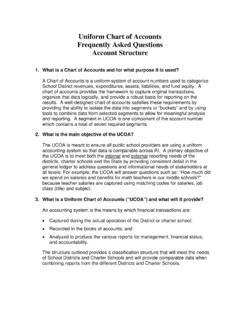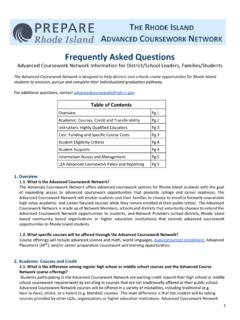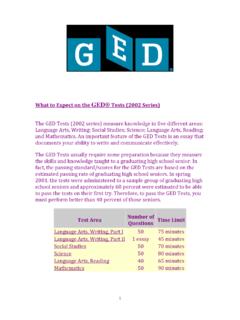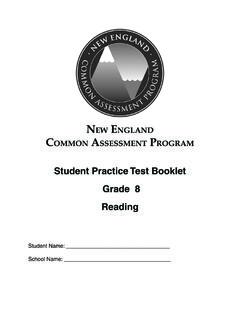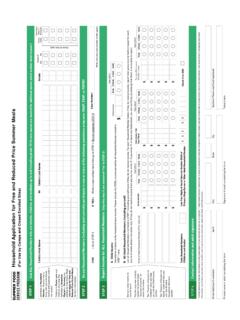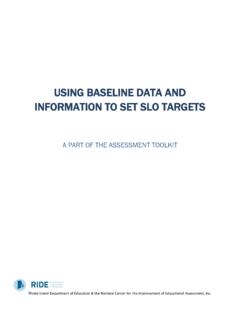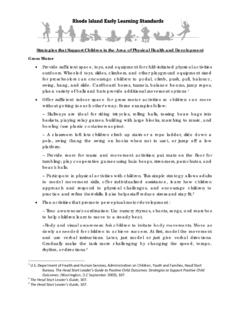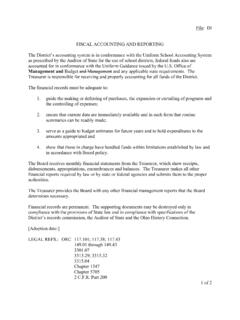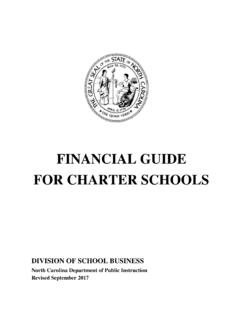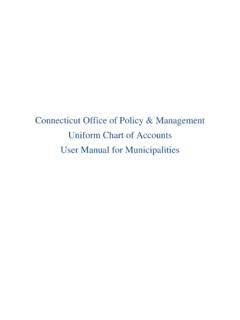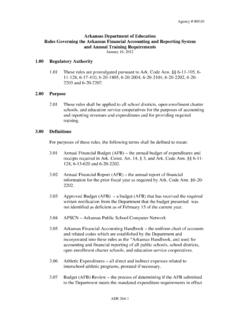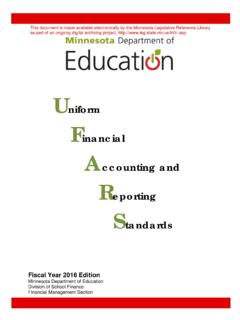Transcription of Uniform Chart of Accounts Frequently Asked Questions Data ...
1 Uniform Chart of Accounts Frequently Asked Questions data and Reporting Definitions/Background 1. What is the Uniform Chart of Accounts (UCOA) and what will it provide? The UCOA is a system of numbers and method of Accounts that all school districts and charter schools will use. The UCOA will provide transparency, uniformity, accountability, and comparability for the financial information from each district and charter school . The UCOA will comply with legislative and NCLB reporting requirements, enable districts and charter schools to comply with General Accepted accounting Principles (GAAP) and Governmental accounting Standards Board (GASB) and Financial accounting Standards Board (FASB) accounting standards, answer Questions regarding return on investment, and provide overall improved financial information for administrators, parents, board members, legislators, and community members. 2. Why was the UCOA developed and why now? General Law charged the Office of the Auditor General and the Department of Elementary and Secondary Education (RIDE) with promulgating a Uniform system of accounting for all school districts in Rhode Island, including a UCOA.
2 RIDE and the Auditor General performed significant work over the past three years to fulfill the mandate and complete the UCOA, which will improve the level of decision-quality data for many users at the state and local levels. We need the UCOA data now more than ever, as the state and local communities continue to close major budget deficits while trying to maintain services for students. 3. Why do we need a UCOA? Rhode Island invests more than $ billion in elementary and secondary public education. Despite the large investments in education, Rhode Island has not established world-class schools and programs throughout the state. We can use the UCOA to identify effective practices by linking investments in education to increases in student achievement. For the first time, school leaders, teachers, parents, legislators, and other education stakeholders can compare financial data across school districts in a reliable, consistent manner. 4. Is the UCOA required to be used?
3 If so, by whom? Yes. By statute, all districts, charter schools and state-operated schools must use the UCOA and follow all of the requirements of the UCOA accounting Manual. 5. What account period does the UCOA data released in March 2011 cover? The financial information released in March 2011 represents fiscal year (FY) 2010, covering the period July 1, 2009, through June 30, 2010. This is Year One of the UCOA. As we collect additional data and get feedback from those using the UCOA reports, we will continue to improve and refine the UCOA system every year. 6. Who designed the UCOA? The Department of Elementary and Secondary Education (RIDE), in partnership with the Auditor General and all school districts in the state, has implemented this unprecedented financial reform. 7. How was the UCOA developed? The work performed to develop the UCOA included the following: gathered information from six (6) states concerning their Chart of Accounts structure and reporting requirements; surveyed a wide variety of policymakers and stakeholders from the state to the local level to determine their information needs; surveyed all districts to update information concerning their current accounting structures and systems to assist in the needs-analysis; met with representatives from the New Mexico Department of Education concerning their implementation of a statewide Uniform Chart of Accounts ; surveyed all vendors of accounting software currently in use in Rhode Island districts concerning the capabilities and limitations of their systems; met several times with the Association of school Business Officials to update them on the project and answer Questions .
4 Met with software vendors representing two or more Rhode Island district clients to view their accounting software in more specificity; conducted follow-up surveys with all vendors to gather vendor and district specific cost information concerning the implementation of the Uniform Chart of Accounts ; reviewed the vendor cost estimates with districts to validate the estimates for both external and internal costs; met with the Advisory Council on school Finances to review the project status; and met with independent auditing firms to discuss and obtain feedback on the audit requirements mandated in the UCOA accounting Manual. In addition, to gather necessary input and to provide additional guidance for the successful outcome of this project, RIDE and the Office of the Auditor General established a hands-on committee, the UCOA Workgroup. The UCOA Workgroup consisted of representatives from the membership of the Advisory Council on school Finances along with districts involved in piloting the UCOA.
5 This group spent more than a year working on the structure, coding, and content of the UCOA, providing feedback as well as reviewing and approving the components developed during the process. A second group, the UCOA Focus Group, which encompassed school finance officers and school finance staff members not involved as pilot districts met several times for the purpose of expanding the input, guidance, and direction available to RIDE throughout this process. 8. What is the main objective of the UCOA? The UCOA is meant to ensure that all public- school providers are using a Uniform accounting system so that data are comparable across Rhode Island. A primary objective of the UCOA is to meet both the internal and external reporting needs of the districts, charter schools, and the State by providing consistent detail in the general ledger to address Questions and informational needs of stakeholders at all levels. For example, because teacher salaries are captured using matching codes for salaries, job class (title), and subject, the UCOA will answer Questions such as: How much did we spend on salaries and benefits for mathematics teachers in our middle schools?
6 9. What are the other objectives of the UCOA? The UCOA was designed to accomplish the following key objectives: to establish a Uniform , comprehensive, minimum Chart of Accounts statewide to improve financial- data collection, reporting, transmission, accuracy, and comparability across Rhode Island school districts and charter schools; to meet the needs of both small and large districts and charter schools while retaining comparability of collected and reported data ; to ensure that districts and charter schools comply with GAAP developed by the GASB; to allow for timely and accurate recording of financial transactions; to create a logical framework that all can use to determine where monies for education originate and how schools, districts, and the state use these funds; to provide comprehensive, full disclosure of the financial position of the reporting district or charter school to parents, administrators, board members, RIDE, legislators, and other interested parties.
7 And to reduce the administrative burden on districts and charter schools, as well as RIDE, in preparing required financial reports. 10. What are the main attributes of UCOA? The UCOA data provides a detailed, school -specific representation of revenues and expenditures. Specifically, the UCOA provides: Transparency Clear, detectable view of how dollars are invested in logical, granular detail; Uniformity Conforming to the same principles, standards, or rules used from district to district to ensure consistency; Accountability Precise rules for capturing and reporting data aligned to specific goals and objectives; and Comparability Uniformity of method and content to allow comparison between different districts and charter schools. UCOA data 11. How does the UCOA allow for comparability? The UCOA provides uniformity of method and content to allow comparison between different districts and charter schools. The UCOA standardized account -code structure allows for every district and charter school to use the same account codes and methods for tracking costs.
8 For example, account codes for mathematics textbooks in Providence are the same as in Warwick and Cranston. 12. Why do some costs vary significantly from district to district? The UCOA data may reveal significant spending discrepancies among schools and districts. We caution users of the UCOA against jumping to conclusions or making assumptions. If you note an apparent discrepancy an especially high or low district expenditure in any area ask for an explanation. For example, you may ask: Why is my district spending so much for nutrition services compared with other districts? One should not assume that the district is spending too much on nutrition and should redirect those resources to instruction. A viable explanation would be that the district is an urban district with high numbers of students enrolled in the free- and reduced-price lunch program and receiving significant USDA federal dollars that the district must spend only on nutrition services. 13.
9 Does the UCOA data include only expenditures? No. The UCOA establishes a complete fund accounting system , including the recording of assets, liabilities, fund balance (fund equity for business-type funds), revenues, and expenditures. 14. Why are there negative values within the financial data in some districts? school districts and charter schools routinely make adjustments to financial data , and there are times that a particular line item is over-adjusted, which results in a negative number in the budget object code. The standard accounting rules within UCOA identify specific revenue that must be offset against expenditures. In some cases, that revenue credit may have been erroneously coded to a different account line than the actual expense, creating a negative value. The expectation is that as districts become more experienced with the UCOA, they will be able to identify these corrections prior before they submit data to RIDE. 15. Does the UCOA allow for districts to provide budget information?
10 Budget figures, as opposed to actual expenditures, were optional in the FY2010 data but will be required for FY2011 data . 16. Does the information RIDE receives contain all transactions of the district? No, RIDE receives summary-level data only. 17. How do districts submit the information to RIDE? The district uploads a text file into the eRIDE portal on the RIDE Web site. Currently, districts use this password-accessible portal to access other reporting modules. An existing module was amended in the system to accept the UCOA data . The text file uploaded contains the account number along with the dollar values for budget and actual. 18. How often will RIDE receive data uploads? Districts are required to upload their data files on a quarterly basis on the 15th of the month following the end of the quarter. Each upload file contains cumulative data from the beginning of the fiscal year through the end of the reporting period. A final post-adjustment/closing file is due on September 30th.
